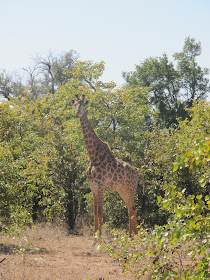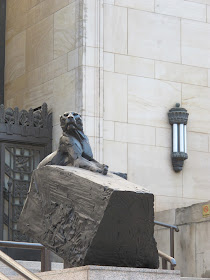(Read part 1 here. Click on photos to enlarge and view gallery)
During my planning for this week long trip to the Kruger I had completely failed to understand the sanparks.org website (the official website for booking accommodation inside the parks). The website has since been explained to me (you must register first to see availability, the link is very well hidden here). Alas when I first tried to book on the sanparks website, it seemed everything was booked and so I had settled for a lodge just outside the town of Phalaborwa instead.
During my planning for this week long trip to the Kruger I had completely failed to understand the sanparks.org website (the official website for booking accommodation inside the parks). The website has since been explained to me (you must register first to see availability, the link is very well hidden here). Alas when I first tried to book on the sanparks website, it seemed everything was booked and so I had settled for a lodge just outside the town of Phalaborwa instead.
The Tingala Lodge is a lovely laid back kind of place with a distinct make-yourself-at-home
kind of vibe. It is about 20 minutes' drive from the gate to the Kruger (most
of that distance on dirt roads) and set in its own conservancy which has all
kinds of small wildlife such as wild pigs, guinea fowl, impala and duiker as
well as a small gang of young male elephants who we could hear charging through the trees at night. The lodge is a 6 bedroomed house
with an open kitchen, dining tables outside overlooking the bush and a big fire
where everyone kicked back and relaxed at night - it felt like staying over at
a friend's house and I can imagine this would be the perfect place to rent out
with a group of friends and family. Tingala is run by a young couple who are
both crazy about nature. The wife (a Brit expat) is an animal scientist by
trade whilst the husband (South African) works as a safari guide in the park.
They both know a lot about the area and were full of interesting facts about South
African wildlife.
 |
| Tingala |
We spent our
nights at Tingala cooking up meat and veggies on the braai before settling in
around the fire with marshmallows and possibly one too many glasses of wine. We scanned the night skies picking out the constellations and gazing at the milky way before the huge red moon would rise (apparently it is red because of the wood smoke pollution). Being
up in Limpopo province the temperature was perfect to sit outside in a jumper
and relax, whilst the days were noticeably warmer than down south or up on the Highveld.
In summer the area gets incredibly hot though and mosquitoes can be a nuisance.
The area is malarial so it's worth being careful not to get bitten too much if
you can help it.
Safari top trumps
In the
Phalaborwa area we saw many of the same animals which we had seen previously in
the park, but with the luxury of time we were able to explore further and admire
more of Kruger's physical beauty. There are two camps in this area: the Letaba
Camp and the Olifants Camp. Both are inviting small camps located on
spectacular river outcrops. I would recommend the Olifants camp in particular
as the view of the river was incredible, the camp felt small and intimate and the area around it
was teeming with game.
 |
| The Olifants river, or as I like to think of it Hippo river |
We came
frustratingly close to finally seeing a leopard shortly after entering the
park. Spotting some bush 'action' we parked up for a while to sit and watch as
a huge herd of buffalo arrived to drink at a waterhole. Then, according to someone
we later met whilst having coffee at the rest camp (who goes down as probably
one of the most annoying people you can ever meet on a safari), just 10 minutes
after we left the most giant leopard appeared on the road right beside the
parking space and just sat there posing for photos. And, that's how it goes
with safari, it's all luck.
John's mum
whilst browsing the pictures of the giant leopard, carried on the conversation
with 'well, we saw some beautiful zebras crossing the road with a sweet baby zebra….'. No, sorry John's mum, sadly zebra does definitely not
trump leopard.
 |
| very sweet baby zebra |
Night safari
Myself and
John were really desperately keen to go on a night safari and so on our last
night we booked an official SAN Parks drive for 400Rand each at the gate. The
night drive set off at 16:00 and was supposed to return at 19:30, although to
our joy the tour went on all the way until 20:15 as we spotted more animals on
the way back to the gate.
I cannot recommend
a night drive highly enough. Enjoying the sunset out in the middle of the park
is an amazing experience and whilst out by yourselves at night (there was only
one other vehicle setting off from the gate that night) you really start to
feel the bush come alive. Our charismatic driver David parked up by a dry river
bed so we could enjoy the sunset and watch as a large herd of elephants
trundled off into the bush in a cloud of dust. We had our sundowners and took
photos whilst listening to the strange and unsettling nearby crunching,
crashing and growling sounds. I would have been devastated if David had ever
needed to use his gun to protect us, but boy, I would not have had the
confidence to be sitting out there at night without it.
 |
| sundowner stop off and another amazing African sky |
On our long
drive with our eyes peeled for action, we spotted again many elephants,
different kinds of hares, klipspringers, chameleons (how David could see them
from so far off whilst driving is a miracle), buffalos, a porcupine (crossing
the road it seemed as if it was on wheels, legs are not at all visible) and
rarely for this part of the park a large herd of wildebeest going round in
circles (wildebeest without a doubt are the stupidest animals in the bush).
The way to
spot animals in the dark is to look for the light of your lamp reflecting off
their eyes. The eyes of vegetarian animals like antelope and wildebeest will
appear greenish- yellow or even blue, whereas carnivores' eyes are more usually
red or orange. During our drive David spotted some red eyes crossing the road
in his headlamps. We zoomed up to search for this lion/leopard/hyena/wild dog.
After careful scanning of the bush with our lamps, hearts beating, all
wondering who would be first to spot the tail, the spots, the teeth….we found
it. The elusive and difficult to track African Wild Cat.
African wild
cats look just like regular domesticated cats except meaner and leaner and are
apparently quite unusual to spot on a safari. However, when all is said and
done, wild cat also does not trump leopard.
We also learnt
a bit about the history of the area on our drive. For example when the first
fences were built tens of thousands of wildebeest died. Wildebeest are migratory
animals and this particular grouping were trying to head for the mountains.
They reached the fence and just stopped there not knowing what to do and
eventually starved to death in their thousands.
It was also
cool to hear about the people living in this area before it was decided to
fence it off to create a nature preserve (these people were displaced into
other parts of Limpopo around 150 years ago). One of the local tribes had their
village based around a large rocky koppie (hill) just a few kilometres from the
Phalaborwa gate. It is visible for miles and is now overrun with baboons whose
sillouttes looked amazing against the dusky sky .It is said that the chief of
the tribe would sit right up at the top of the koppie on a kind of natural rock
chair with a big stick surveying the land. Looking at this rock and thinking of
the chief with his big stick looking out over the animal kingdom…seems to me I
know where they got the inspiration for the big rock in the Lion King.
 |
| Lion King rock |













































